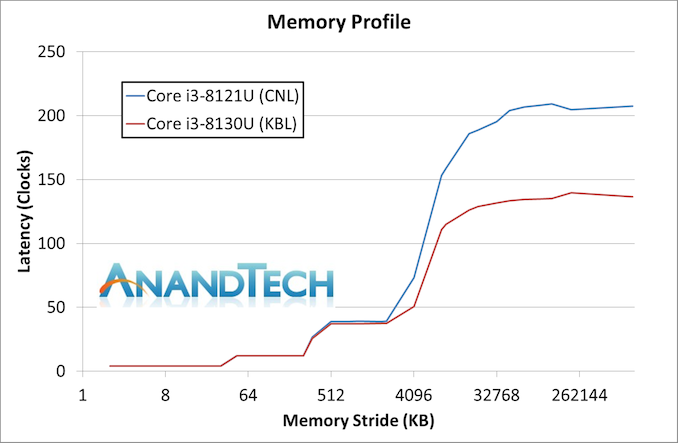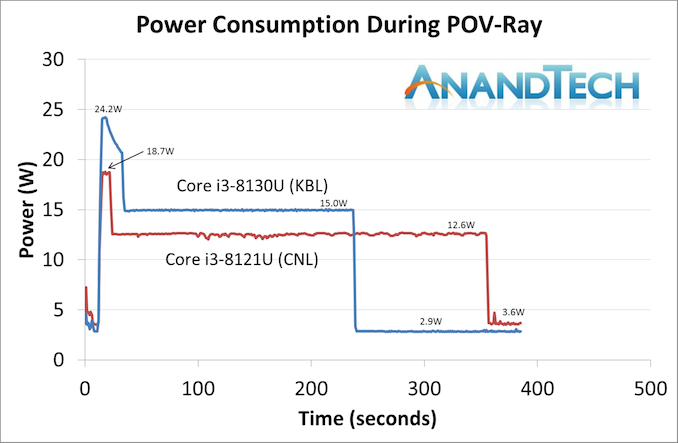Intel's 10nm Cannon Lake and Core i3-8121U Deep Dive Review
by Ian Cutress on January 25, 2019 10:30 AM ESTCPU Performance: Memory and Power
Memory
With the same memory setup as the standard Skylake-style core, without any other improvements, we should expect Cannon Lake to perform exactly similar. Here’s a recap of the memory configuration:
| Memory Comparison | ||
| Skylake Desktop | Cannon Lake | |
| L1-D Cache |
32 KiB/core 8-way |
32 KiB/core 8-way |
| L1-I Cache |
32 KiB/core 8-way |
32 KiB/core 8-way |
| L2 Cache |
256 KiB/core 4-way |
256 KiB/core 4-way |
| L3 Cache |
2 MiB/core 16-way |
2 MiB/core 16-way |
| L3 Cache Type | Inclusive | Inclusive |
For this test we put our Cannon Lake and Kaby Lake processors through our Memory Latency Checker test. Both systems had turbo modes disabled, forcing them to run at 2.2 GHz for parity and a direct microarchitecture comparison.
In this instance we see very little different between the two through the caches of the chip. Up to about 2MiB, both chips perform practically identical. Beyond this however, going out to main memory, there is a big discrepancy between the Kaby Lake and the Cannon Lake processor. In essence, accessing Cannon Lake main memory has an additional 50% latency.
At first we thought this was a bug. For both systems to have dual channel memory and running DDR4-2400, something had to be wrong. We double checked the setups – both systems were running in dual channel mode, giving the same memory bandwidth. The Cannon Lake processor was running at DDR4-2400 17-17-17, whereas the Kaby Lake system was at DDR4-2400 16-16-16 (due to memory SPD differences), which isn’t a big enough change to have such a big difference. The only reason we can come up with is that the memory controller on Cannon Lake must have additional overhead from the core to the memory controller – either a slower than expected PLL or something.
Power
Measuring the power of these thermally limited systems is somewhat frustrating in that we are at the whims of the quality of silicon at play. Bad silicon can get hotter faster, causing thermal throttling, or it depends on how the systems are set up for the peak power numbers. We use AIDA’s power monitoring tool to give us the power numbers for the CPUs during our POV-Ray test.
If you saw our How Intel Measures TDP article, you may be familiar with the concept of Power Limits. Intel processors have several power limits set in firmware – these values are set by the system manufacturer, and Intel provides ‘guidelines’. The two key values are Power Limit 1 (PL1), which describes a steady state scenario, and Power Limit 2 (PL2) which describes a turbo scenario. The reason why the system manufacturer gets control of these is because they might put a high wattage processor into a small form factor system, and need to manage performance – this is why we sometimes see a Core i7 be outperformed by a Core i5 in the same system design.
In most cases, PL1 is set to the TDP of the processor – in this case, it should be 15W. As shown on the graph above, this is true for our Core i3-8130U system, which shows a steady state power consumption of 15.0W. The Cannon Lake processor however only peaks at 12.6W.
PL2, the turbo power of the processor, can also be determined. For the Kaby Lake processor, we see a peak of 24.2 W, while the Cannon Lake has a turbo only of 18.7 W. We see that the turbo time period for the Cannon Lake processor is also much shorter, leading to a PL1 / steady state power much sooner.
Part of this is because we are pitting the Cannon Lake laptop against the Kaby Lake mini-PC. That being said, the Cannon Lake laptop is a beefy 15.6-inch unit, and has cooling for both the CPU and the discrete RX540 graphics, which isn’t doing much during this test except showing a basic 2D display.
That is arguably a lot more cooling than the mini-PC provides, plus we are cooling it with additional fans. These settings are more a function of both Lenovo doing what it wants to in firmware that we can’t change, but also the chip as engineered.
We can also calculate some level of efficiency here. By taking the area under the graph and correcting for the base line power (2.9 W on KBL, 3.6 W on CNL), we can calculate the total power consumed during the test. We get the following:
- Core i3-8121U (CNL) consumes 867 mWh
- Core i3-8130U (KBL) consumes 768 mWh
So this means that Cannon Lake is slower in AVX2 frequency, consumes more power, and scores 25% less in POV-Ray (see previous pages). That’s damning for the design.
To further look into this data, we disabled the turbo modes on both processors and ran our POV-Ray workload adjusting the number of threads being loaded and then measured the power consumption. In this scenario we are running at the same frequency, measuring the steady state power, and are thus at the whims of both the voltage set on both processors and the efficiency. Our tool also lets us measure the power of just the cores, so we’ll plot core power against threads loaded.
If this graph was the definitive graph, it shows that Cannon Lake is vastly inefficient (at 2.2 GHz) compared to Kaby Lake.














129 Comments
View All Comments
0ldman79 - Friday, January 25, 2019 - link
This whole situation begs the question, what could Intel have gotten out of 65nm, 32nm, 22nm, etc, had they run it for five generations.I wonder if they'll do similarly on the 10nm process, punt the first time or two then knock it out of the park. Skylake was a beautiful success. Maybe Sunny Cove will be the same for 10nm.
StrangerGuy - Friday, January 25, 2019 - link
The point is Intel now needs better uarch designers lot more than process designers. Yes 10nm improvements is hard work and an interesting read...but for users they ultimately only care about end performance and perf/$, not die sizes, transistors/mm2 or manufacturing margins. If Zen 2 blows the doors off CFL would anybody even care about about Intel's process advantage? Hell not.KOneJ - Sunday, January 27, 2019 - link
Doubt this is even an "if" at this point. Curious to see if *Cove cores can keep Zen 4 and later from running away too much. Only time will tell, but Intel bringing in guys like Keller can't possibly be a bad thing. And in spite of their disastrous former attempts at building a dGPU, I fully expect Intel to make it happen this go around.eva02langley - Sunday, January 27, 2019 - link
The problem is, do you believe 7nm would be any different? Unless they implement EUV directly, I don't see it. Intel will be force, like AMD, to go fab less because their node will not be better than the competition. To add to it, it is most likely be behind in time to.zodiacfml - Saturday, January 26, 2019 - link
Great job again though it doesn't warrant it for this Intel junk. Looks like they're paying Lenovo just to use Cannon lake, usable chips that came from tuning manufacturing.The performance is where I expected it to be.
I still stand to my theory that Intel is reluctant to spend, leaving their engineers stressing if they can produce 10nm products without new equipment.
Anyways, it is a dead horse. AMD will be all the rage for 2019.
KOneJ - Sunday, January 27, 2019 - link
"Intel is reluctant to spend"To the contrary: throwing money at the problem is exactly what they're doing. Have you tracked their CAPEX these past few years?
"AMD will be all the rage for 2019."
I think that's basically a given.
zodiacfml - Sunday, January 27, 2019 - link
The reports were pretty vague and I don't remember them spending substantial money except the news that they're spending for more capacity on 14nm.AMD is pretty lukewarm for me last year. I'm certain that this year will be a lot stronger for AMD until Intel and Nvidia starts taking their customers more seriously.
KOneJ - Sunday, January 27, 2019 - link
Even for a company Intel's size, spending north of $12B a year isn't penny-pinching. I know their revenue and margins are massive, but their failings haven't been a lack of spending since SB. They've been progressively spending more than ever.YoloPascual - Saturday, January 26, 2019 - link
bUt 10nm iNtEL iS bEtTeR tHaN 7nm TSMC riGhT?KOneJ - Sunday, January 27, 2019 - link
Shouldn't your alias be yOlOpAsCuAl, wannabe troll?